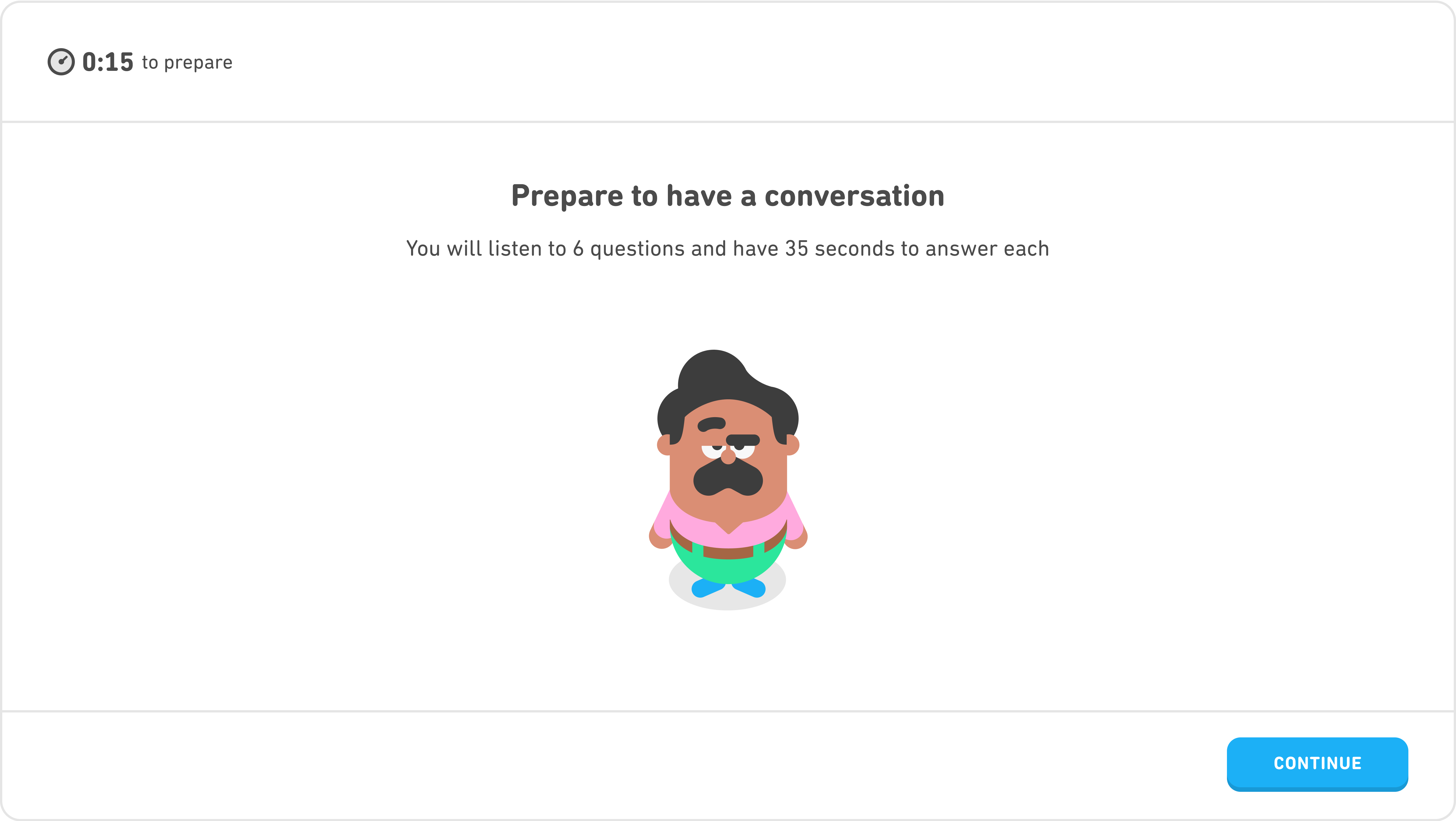什么是 Duolingo 互动口语?
Duolingo 互动口语 是一种革命性的问题类型,于 2025 年 7 月推出,取代了之前的听说格式。这个 互动口语 部分以对话形式呈现问题,学生需要听取 6-8 个问题,并在每个问题后立即作出回答。
互动口语的主要特点
互动口语的挑战在于其时间限制和适应性:
- 每个回答 35 秒,不提供准备时间(开始时有 15 秒)
- 音频仅播放一次 - 需要仔细聆听和准确理解
- 自适应提问 - 后续问题会根据您之前的回答进行调整
- 每次测试两个主题组,主题转换通常发生在第 4-5 个问题左右
与其他 DET 口语部分不同,Duolingo 互动口语要求快速思考和自然的对话能力,测试您的语言基础和实时口语技能。
互动口语问题类别
互动口语涵盖多种主题,可以组织为 8 个主要类别:
1. 个人成长与价值观
关于错误、学习经历和个人发展的问题
2. 教育与学习
学术经验、学习方法和教育挑战
3. 工作、职业与经济
专业经历、工作场景和职业目标
4. 科技与未来
数字趋势、科技影响和未来预测
5. 社会、关系与沟通
社会互动、社区参与和人际交往技能
6. 文化、艺术与媒体
文化经历、艺术偏好和媒体消费
7. 生活方式与日常活动
日常例行、爱好和个人偏好
8. 环境与公共空间
环境问题、公共设施和社区空间
注意:由于 互动口语 包括主题转换,因此一次测试通常会涵盖两个不同的类别。
互动口语的评分方式
与其他开放式 DET 问题一样,AI 根据以下标准评估您的互动口语回答:
语法与词汇
- 语言结构的多样性和复杂性
- 语法使用的准确性
- 高级词汇的选择
内容相关性
- 直接回应 所提出的问题
- 适当的深度 和细节
- 观点之间的逻辑联系
流利度与发音
- 自然的语音节奏 和速度
- 清晰的发音 与正确的语调
- 最小的犹豫 和流畅的表达
内容相关性和流利度对于 Duolingo 的互动口语 成功尤为重要。
有效的互动口语策略
策略 1:积极倾听与分析
由于互动口语音频仅播放一次,因此发展这些听力技巧:
- 快速识别问题类型(描述性、基于意见或分享经历)
- 提取关键信息,同时过滤掉过渡短语
- 识别主题转换,使用像“我想换个话题,问你关于...”这样的话语
策略 2:结构化回答框架
使用经过验证的结构组织您的互动口语回答:
对于意见问题:
- 陈述您的观点:“在我看来...” / “从我的角度...”
- 提供理由:“主要原因是...” / “这是因为...”
- 举例说明:“例如...” / “一个很好的例子是...”
- 总结:“因此...” / “总之...”
对于经历问题:
- 设定场景:“我记得有一次...” / “有这样的场合,当...”
- 描述情况和您的行动
- 解释结果:“因此...” / “这导致...”
- 分享教训:“这教会了我...” / “我学到的是...”
对于描述性问题:
- 介绍主题:“我想描述...”
- 添加细节:“首先,它以...而闻名” / “另一个值得注意的点是...”
- 提供例子:“例如...” / “比如说...”
- 总结:“总体而言,这显示...” / “总之...”
策略 3:时间管理精通
有效的互动口语需要精准的时间管理:
- 目标每个回答 4-5 个句子
- 争取 30 秒 的发言时间
- 使用计时器练习,以培养内在时钟
- 避免匆忙 或说得太慢
策略 4:准备多样化的故事
为 Duolingo 互动口语创建可适应的“备用故事”:
- 个人成长经历(克服挑战,从错误中学习)
- 团队合作故事(小组项目,领导经历)
- 日常生活轶事(旅行、爱好、难忘的时刻)
- 学术或专业经历(成就,解决问题)
多样化故事示例:
基础故事: “去年,我自愿领导学校的一个小组项目。一开始,我很紧张,因为我从未管理过团队。我犯了一些错误,比如时间管理不当,但我学会了更好地沟通并分配任务。最后,我们成功完成了项目,我更加自信。这次经历教会我走出舒适区是成长的最佳方式。”
这个故事可以根据以下问题进行修改:
- 从错误中学习(关注时间管理错误)
- 领导经历(强调管理的方面)
- 个人成长(突出获得的自信)
- 团队合作(讨论分配和沟通)
重要提示:
- 始终调整故事以适应特定问题 - 不要逐字使用
- 多次练习讲述您的故事,以控制时间
- 专注于自然的表达 - 您的故事应该听起来像对话,而不是背诵
- 变换语调和语速,以避免听起来像机器人
互动口语练习示例
让我们来看看一个包含 6 个问题的完整互动口语示例,涵盖两个主题。这个示例将展示如何在真实测试场景中应用我们讨论的策略。
问题 1-3:个人成长与价值观
练习提示:在您听每个问题时,尽量识别关键字和问题类型。在真正的测试中,您无法做笔记,但在练习期间,您可以写下关键词来提高您的听力技巧。
问题 1
音频: “我想问您几个关于错误和误解的问题。告诉我一个您从中学到积极东西的错误。”
分析:这是一个经验分享问题,询问从错误中学习的经历。关键字:“错误”,“学到积极的东西。”
现在,让我们看看如何使用我们准备的故事和分享经历模板构建一个有效的回应:
问题 2
音频: “谢谢,我有一个不同的问题。告诉我一个您混淆了两个相似事物的时候。”
分析:另一个经验问题,但有一个具体焦点。关键字:“混淆”,“两个相似事物”,“一个时候。”请注意,这如何基于前一个主题,同时询问不同的角度。
关键策略:这就是互动口语的自适应性质显现出来的地方。这个问题建立在我们关于错误的前一个回答上,但要求一种特定类型的错误。我们可以调整我们准备的故事以适应这个新角度,同时保持一致性。
问题 3
音频: “有趣,我还有一个问题。您对向他人承认错误的感觉如何?”
分析:注意转换词“有趣”——这是 AI 对您之前答案的反应。问题从询问经历转向询问观点。关键字:“您感觉如何”,“承认错误。”
关键策略:这展示了互动口语的自适应性质——问题与您之前的回答相关,但从经验分享转向基于意见的提问,需要使用意见结构。您仍然可以引用以前的例子作为支持证据。
问题 4-6:生活方式与日常活动
在这里,我们看到在 互动口语中通常发生在第 4 或 5 个问题周围的主题转换。请注意所使用的过渡语言。
问题 4
音频: “感谢您与我讨论错误和误解。现在我想换个话题,问您一些关于自拍或拍摄自己照片的问题。您认为自拍是分享体验的好方法吗?为什么或为什么不?”
分析:第一部分是过渡语言——“感谢您讨论……我现在想换个话题”——这对您的回答没有有用的信息。实际问题在最后:“您认为自拍是分享体验的好方法吗?为什么或为什么不?”这是一个意见问题。
关键策略:注意明确的主题转换,并准备一个与生活方式主题相关的新故事。由于这是关于通过自拍分享体验,准备一个关于旅行或社交活动的例子。
针对生活方式主题的准备故事:“去年在一次家庭旅行中,我们早上早起爬山。小径很艰难,但顶上的风景令人难以置信——晴空万里,新鲜的空气,无尽的绿意。我和父母一起自拍,大家都在微笑,还有些气喘吁吁。后来,我把这张照片分享在网上,很多朋友说他们感觉像是和我们在一起。那个时刻让我想起,照片不仅能捕捉地方,还能捕捉我们共同经历的情感。”
问题 5
音频: “好的,我还有一个问题。描述一些人们常常自拍的地方。”
分析:这是一个描述性问题,询问具体信息。关键字:“描述”,“地方”,“人们常常自拍。”这个问题继续了自拍的主题,但请求的是事实描述,而非个人意见。
问题 6
音频: “好的,让我问您另一个问题。自拍如何改变了年轻人之间的沟通?”
分析:另一个描述性问题,但询问变化和影响。关键字:“自拍如何”,“改变了”,“沟通”,“年轻人。”这需要您讨论转变和影响。
高分的关键成功因素
要在互动口语中获得高分,请关注以下关键领域:
1. 掌握回应模板和结构
通过广泛的练习熟悉各种回应框架。您的目标是自然地使用这些结构,使其成为第二天性,从而提高流利度和逻辑组织。
2. 发展故事调整技能
由于互动口语问题多样且不可预测,您无法为每个可能的问题准备具体的故事。相反,请练习修改您准备的故事,以适应不同的上下文和问题角度,同时保持真实性。
3. 保持自然流利
您的回答应该听起来像自然对话,而不是排练演讲。专注于:
- 减少不必要的停顿和重复
- 使用自然的语调模式
- 以对话的速度说话
- 即使使用准备的材料也要听起来自发
互动口语成功的高级技巧
掌握回应模板
记住这些互动口语句型开头,以实现流畅的表达:
观点表达:
- “在我看来...” / “从我的角度...” / “我相信...” / “就我个人而言,我认为...”
理由短语:
- “主要原因是...” / “这是因为...” / “另一个原因是...”
示例引入:
- “例如...” / “比如说...” / “这个的一个很好的例子是...”
经验开头:
- “我记得有一次...” / “有这样的场合,当...” / “去年,我...”
结论标记:
- “因此...” / “总之...” / “要总结,我觉得...”
发展故事调整技能
由于 Duolingo 互动口语问题差异很大,请练习修改您准备的故事:
- 保持核心叙述的同时改变焦点
- 调整细节以符合问题要求
- 根据问题角度变换所学的教训
- 保持相关问题之间的自然流程
确保自然表达
互动口语的成功需要对话的真实性。这一点尤其重要,因为 AI 评分系统可以检测到当回答听起来过于排练或不自然时:
- 练习自然的语调 - 避免单调的表达,听起来像在读书
- 使用合适的重音和节奏模式,匹配自然的说话方式
- 最小化填充词和不必要的停顿,以保持流畅
- 保持适中的说话速度 - 既不要太快也不要太慢
- 即使使用准备的材料也要听起来自发
- 适当使用升降调,以避免听起来平坦
- 避免听起来像在朗诵 - 听起来像预先背诵的回答可能被标记为准备的答案,可能会影响评分验证
互动口语常见错误及避免方法
1. 机械的表达
避免听起来像在背诵记忆文本。练习改变语调和语速,听起来更自然。
2. 忽视时间限制
不要匆匆回答或留下长时间的沉默。练习计时,以始终如一地提供 30 秒的回答。
3. 偏离主题的回答
始终关注所提问的具体问题。未能解决问题的通用回答将损害您的分数。
4. 过度使用准备的故事
虽然备用故事很有帮助,但请有意义地调整它们,而不是强行使用无关的叙述。
5. 较差的听力理解
由于音频仅播放一次,因此发展集中聆听技巧,以捕捉关键问题元素。
互动口语准备清单
考试前:
- 使用 35 秒计时器进行练习
- 为每个类别准备 3-4 个可调整的故事
- 熟记回答结构模板
- 录制自己以检查发音和流利度
- 练习主题转换和问题类型识别
考试期间:
- 仔细聆听问题类型和关键信息
- 有效利用 15 秒的初步准备时间
- 清晰自然地说话
- 将准备的故事调整以适应具体问题
- 整个过程中保持对话的语气
结论:掌握 Duolingo 互动口语
互动口语代表了 DET 评估的重大演变,需要考生展示实时对话能力。成功取决于结合强大的听力技能、结构化的回应策略、有效的时间管理和自然的表达。
掌握 Duolingo 互动口语的关键在于不断练习本指南中概述的策略。专注于发展多样化的故事库,记住回应模板,并保持对话的真实性。请记住,这一部分特别强调内容的相关性和流利度,因此优先考虑清晰、直接的回答,充分解决每个问题。
通过运用这些经过验证的技巧进行认真准备,您将能够成功应对 互动口语部分,并实现您的目标 DET 分数。
记住,互动口语的根本目的是展现您自然有效地进行实时对话的能力。虽然准备至关重要,但您的目标应该是将这些策略内化到如此程度,以至于在实际测试中感到自然。







